Originally published by IslamicWorldNews
The B-2 Spirit is a strategic heavy stealth bomber designed to carry and deploy both nuclear and conventional weapons. It played a crucial role in the U.S. bomber modernization program. The B-2’s blend of stealth technology, sophisticated aerodynamic design, and substantial payload capacity offers it a notable edge over other bombers. It has a range of approximately 6,000 miles (9,600 km) without needing to refuel.
Introduction:
In the 1980s, global advancements in air defense systems significantly threatened the United States Air Force’s capability to hit crucial enemy targets. To counter this challenge, the Air Force adopted cutting-edge stealth technology for a long-range bomber designed to carry substantial payloads, both conventional and nuclear. The B-2 Spirit, developed by Northrop Grumman, achieved a level of invisibility to advanced radars that was unprecedented at the time, utilizing a flying wing configuration, innovative composite materials, specialized coatings, and secret stealth technologies.
The aircraft was first unveiled to the public in November 22, 1988, at Air Force Plant 42 in California and completed its first test flight in July 17, 1989. After undergoing development, the first operational B-2 was delivered to the United States Air Force in December 17, 1993. The bomber, whose primary base is Whiteman Air Force Base in Missouri, has participated in various operations, the most significant of which include Operation Allied Force in Serbia in 1999, Operation Enduring Freedom in Afghanistan in 2001, and Operation Iraqi Freedom in Iraq in 2003.
The B-2 Spirit can conduct combat missions for over 30 hours without a break, operated by a crew of two (a pilot and a mission commander). It has the capacity to carry precision-guided munitions weighing up to 40,000 pounds for each mission. Earlier B-2 models were subjected to extensive environmental tests, including 1,000 hours of temperature evaluations at the McKinley Climatic Laboratory, ranging from -65 to 120 degrees Fahrenheit. The results of these tests, later confirmed in Alaska, proved that the B-2 Spirit is not only capable of withstanding various climatic challenges but also effectively executes strategic missions with minimal radar detection by adversaries.
History and development of the B-2 bomber:
The concept of designing a stealth bomber dates back to the 1940s and 1950s when Northrop sought to introduce a new approach to military aircraft by developing advanced flying wing designs like the YB-35 and YB-49. This design, lacking a traditional tail, significantly reduced the radar cross-section and could have revolutionized air tactics if completed. However, at that time, the absence of advanced control systems and technological limitations led to these projects being shelved.
In the 1970s, advances in radar-absorbing technologies, advanced composite materials, and digital computing reignited the United States Air Force’s interest in developing a stealth bomber. The Vietnam War experience and the increasing threat of Soviet air defenses underscored the necessity for a strategic aircraft capable of penetrating deep into enemy territory undetected.
In 1979, the United States Air Force launched the Advanced Technology Bomber (ATB) program, which aimed to develop a stealthy strategic bomber capable of striking deep into enemy territory. The project was highly classified, with information only available to a select few senior officials.
Northrop and Lockheed competed for the program. Lockheed, known for its success with the F-117 Nighthawk stealth fighter, proposed a design aligned with those principles. However, Northrop ultimately proved its superiority by creating a flying-wing bomber, securing the contract for the program’s development in 1981.
However, Northrop’s design, which integrated a distinctive aerodynamic shape, radar-absorbing materials, and fully digital flight systems, set the stage for a new era of strategic bombers. The outcome of this initiative, the B-2 Spirit, surpassed all previous bombers in both design sophistication and operational capabilities at the time.
The soaring costs and technical difficulties of the program attracted significant criticism in Congress. By the early 1980s, the estimated project cost was $22.1 billion, but as it advanced, the combination of technical hurdles and escalating research and development expenses caused this estimate to climb to $44.7 billion by 1988. Ultimately, taking into account research and development, production, maintenance, and upgrades, the entire B-2 program cost totaled $101 billion, making each aircraft approximately $2.1 billion. In 1992, the Bush administration opted to cut the aircraft production from 132 to a mere 21. The anticipated cost for producing the 20 aircraft was about $26.8 billion. This assessment bolstered the case against any additional B-2 production. Consequently, Congress decided to stop further production, maintaining 20 operational aircraft and 1 experimental one in service.
Its high maintenance costs and limited fleet prompted the US Air Force to announce in 2018 that the bomber would be retired by 2032, to be replaced by the B-21 Raider, a new generation of stealth bombers.
B-2 design and technical features:
A standout aspect of the B-2’s design is its distinctive flying wing structure, which lacks any vertical or horizontal tails. This feature is intended to minimize radar reflection. The tailless configuration, combined with its expansive wings, effectively lowers the radar cross-section (RCS), enhancing its stealth capabilities. Consequently, the B-2 can operate at high speeds and altitudes while remaining undetectable to enemy radars. Measuring 21 meters in length, 5.18 meters in height, and boasting a wingspan of 52.4 meters, this aircraft ranks among the largest stealth platforms globally.
Since the B-2 is a traditional airframeless aircraft, integrating strength into its structure required the use of advanced materials. For this purpose, special composites such as carbon fiber and metal compounds were used in the fuselage structure, as they are lightweight while also providing high strength and excellent radar absorption. Additionally, to withstand the stresses and pressures from flying at very high altitudes, the body was designed to endure extreme changes in temperature and air pressure.
B-2 Avionics and Guidance Systems:
Another notable feature of the B-2 is its advanced avionics. One of these systems is the AN/APQ-181 multi-purpose radar, designed to detect and track targets under various flight conditions. With its capability to operate in multiple bands, this radar enables the B-2 to identify its targets across a broad spectrum. The system employs radar stealth technology to conduct precise reconnaissance without being detected by enemy defense systems.
The AN/APQ-181 radar is among the most advanced terrain mapping and tracking systems designed specifically for the B-2 Spirit stealth bomber. It operates in the G-band and features 21 operational modes, including terrain tracking, navigation, target acquisition, tracking, and weapons guidance.
The AN/APQ-181 features a modular design that enhances capabilities and reduces failure rates. This system employs two electronically scanned array antennas, providing a broad field of view that covers the front and sides of the aircraft. The radar consists of 10 modular replaceable units (LRUs), with a combined weight of 955 kg and a volume of 1.485 cubic meters. Each antenna has a weight of 260 kg. Designed to meet the MIL-STD-1553 standard, the AN/APQ-181 system is resistant to electromagnetic interference as well as the effects of electromagnetic pulses (EMP). Additionally, the radar is optimized for challenging operating conditions, including low-altitude and high-speed flights. In response to the growing demand for the frequency spectrum by commercial communications systems, the US Air Force initiated a program in 2004 to upgrade this radar to an active phased array (AESA) system.
Alongside radar, the B-2’s sophisticated navigation system incorporates GPS and astro-inertial technology, ensuring accurate guidance through lengthy and perilous routes. These systems are designed to function optimally, even in electronic warfare environments, with the ability to autonomously correct their course when necessary.
Stealth of the B-2 bomber:
Stealth is a key feature of the B-2, enabling the aircraft to stay concealed from modern detection systems such as multi-band radars and infrared sensors. To achieve this goal, the B-2’s airframe was designed to minimize radar reflection by reducing its radar cross-section (RCS). The delta-shaped flying wing configuration, along with the airframe’s sharply angled surfaces that reduce radar reflection, collectively enhance the B-2’s stealth capabilities. The B-2 reportedly has a radar cross-section of about 0.1 square meters.
Another stealth feature of the B-2 is the use of special radar-absorbing coatings called Radar Absorbent Material (RAM). These coatings are applied throughout the aircraft’s body to absorb radar waves, thereby minimizing its radar cross-section.
To lower its thermal signature, the B-2’s engines are uniquely positioned within the body, and their exhaust is carefully shrouded to reduce heat visibility. Additionally, ventilation and cooling systems for the engine’s intake air, combined with efforts to decrease exhaust temperature, effectively minimize the B-2’s thermal signature.
Engine power and performance of the B-2 bomber:
The B-2 bomber features four General Electric GE-100 non-afterburning turbofan engines, generating 77 kilonewtons (17,300 pounds) of thrust. These uniquely designed engines enable the B-2 to achieve speeds exceeding 630 mph (1,010 km/h) at an altitude of 40,000 feet (12,000 m). Additionally, the aircraft can cruise at 560 mph (900 km/h) at the same elevation. With an operational range of approximately 6,800 miles (11,000 km), the B-2 is equipped for long-range missions.
Armament and carrying capacity of the B-2 bomber:
The bomber can carry 40,000 pounds (18,000 kg) of ordnance, which may consist of both nuclear and conventional weapons. Since the Cold War concluded, modifications have enabled the aircraft to effectively deploy conventional armaments as well. It has the capacity to hold up to 80 500-pound bombs, 36 750-pound bombs, and 16 2,000-pound bombs in its two bays. Additionally, the bomber is outfitted with long-range weapons such as the AGM-154 Joint Standoff Weapon (JSOW) and the AGM-158 Joint Air-to-Surface Standoff Missile (JASSM).
To complement the aircraft’s military capabilities, the B-2 is also designed to carry two massive Massive Ordnance Penetrator (MOP) bombs. The 14-ton GBU-57 bunker-busting bomb is ideal for destroying bomb-resistant structures such as bunkers and fortified underground facilities. The B-2 is one of the few platforms capable of delivering these bombs.
The cockpit and flight crew of the B-2 bomber:
The B-2 bomber features an advanced, automated cockpit managed by two pilots. The primary pilot sits on the left, while the mission commander is located on the right. This arrangement enables the flight crew to continuously and seamlessly monitor systems and conduct intricate operations. Additionally, the aircraft is equipped with sophisticated systems that minimize flight crew fatigue, enabling one member to rest or utilize the aircraft’s amenities during extended flights.
B-2 Missions and Operations:
Since entering service in the 1990s, the B-2 Spirit has participated in numerous important military missions. Its first operational appearance occurred during the Kosovo War in 1999, where the B-2 played a significant role in destroying targeted sites, dropping 11 percent of the bombs used in the conflict. The aircraft also marked the first use of JDAM smart bombs.
In the 2000s, B-2 bombers played a crucial role in the Afghanistan and Iraq wars. They undertook one of their longest missions, flying from Whiteman Air Force Base in the United States to Afghanistan and back after refueling. The B-2 also took part in attacks on Iraq from Diego Garcia in the Pacific and other US bases, dropping over 1.5 million pounds of munitions. Additionally, in 2011, B-2 bombers entered Libya as the first American aircraft involved in Operation Odyssey Dawn. By 2025, the bombers were again stationed at Diego Garcia, conducting bombing operations in Yemen.
B-2 bomber specifications:
Type: Strategic heavy bomber
Manufacturer: Northrop Grumman
Country of manufacture: United States
First flight: 1989
Entered service: 1993
Crew: 2
Length: 21 m
Wingspan: 52.4 m
Height: 5.18 m
Engine: 4 × General Electric F118-GE-100 engines without afterburner
Maximum range: 11,000 km
Combat range: 9,600 km
Cruise speed: 900 km/h
Maximum speed: 1,010 km/h
Rate of climb: 3,000 ft/min
Service ceiling: 15,240 m
Endurance: up to 40 hours (estimated)
Empty weight: 71,700 kg
Maximum takeoff weight: 170,500 kg
Payload: 18,000 kg (official), 23,000 kg (estimated)
Armament:
Two internal bays with a capacity of 18,000 kg (46,000 lb) of ordnance
80 × 500 lb class bombs (Mk-82, GBU-38)
36 × 750 lb class cluster bombs (CBU)
16 × 2,000 lb class bombs (Mk-84, GBU-31)
16 × B61 or B83 nuclear bombs
AGM-154 JSOW and AGM-158 JASSM missiles
2 × GBU-57 heavy bunker buster bombs
MORE ON THE TOPIC:




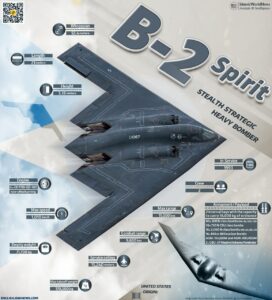
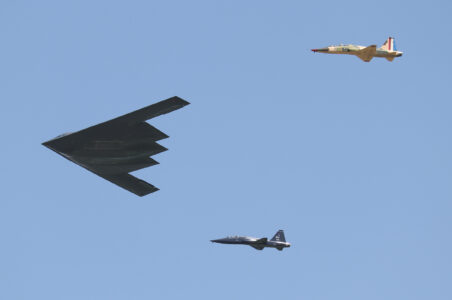
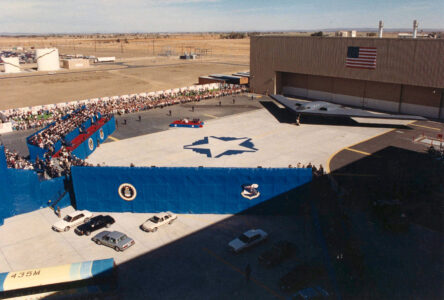
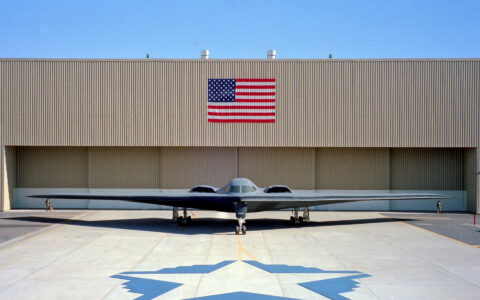
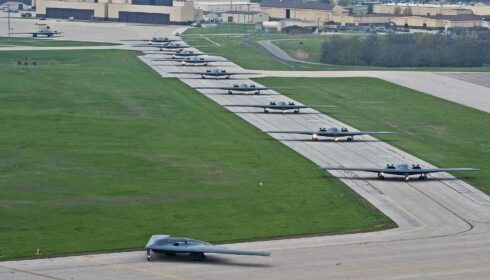
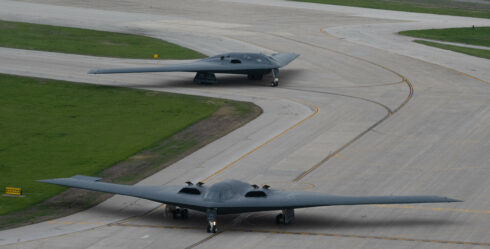
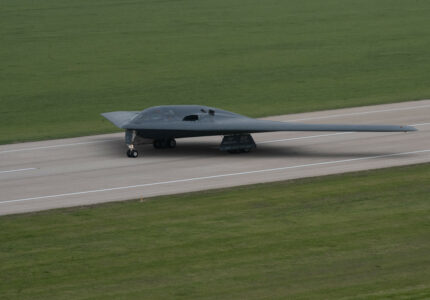
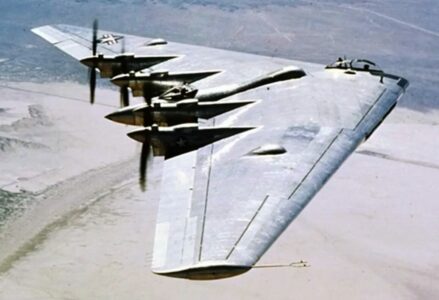
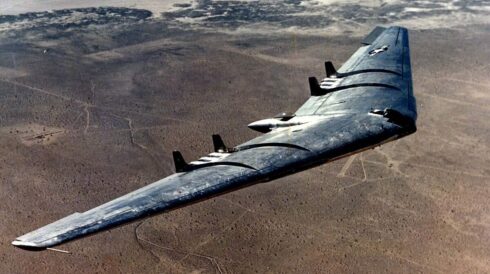
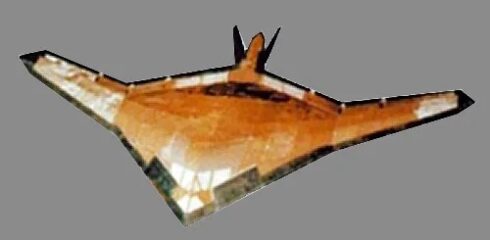
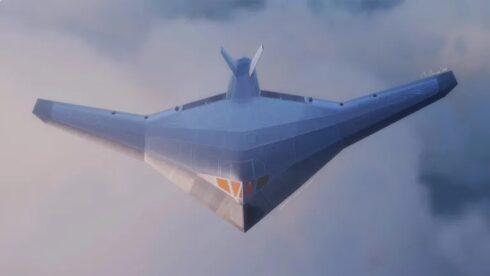
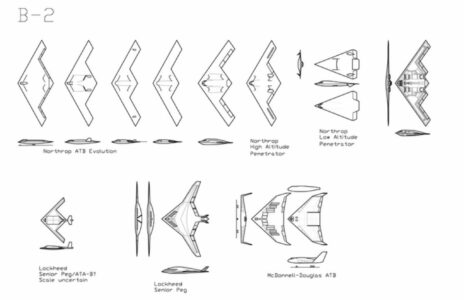
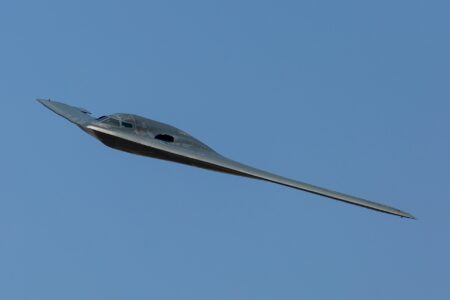
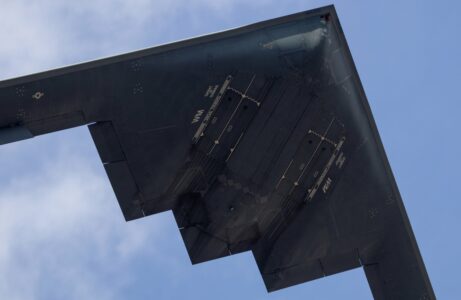
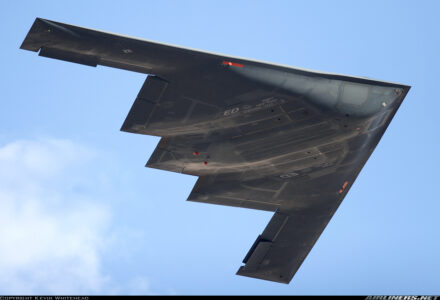
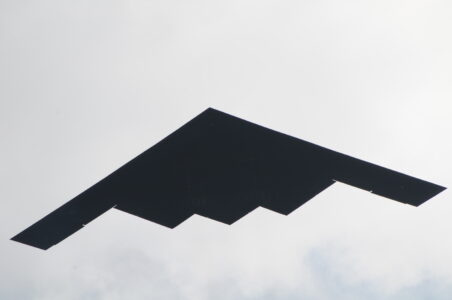
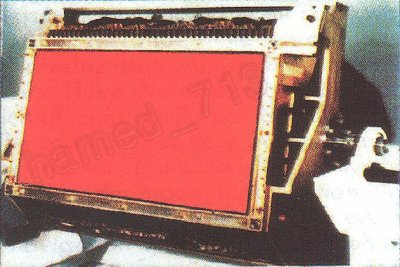
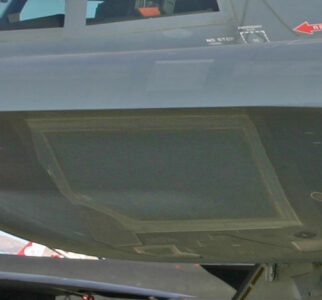
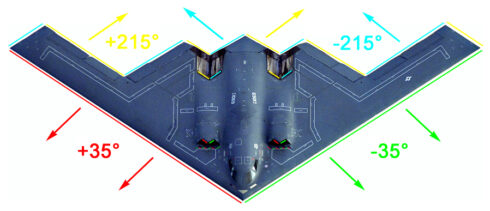
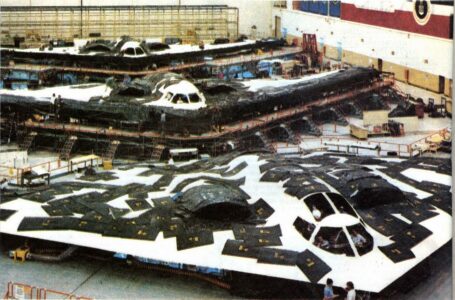
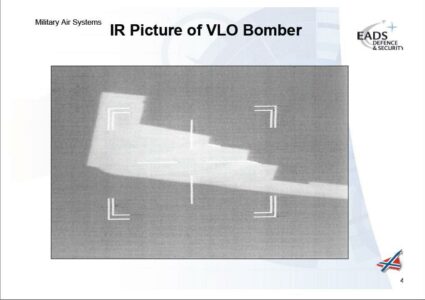
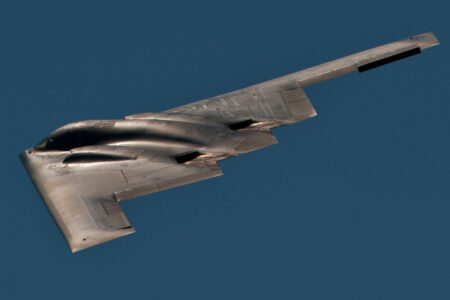

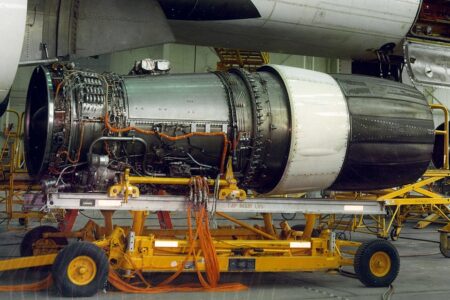

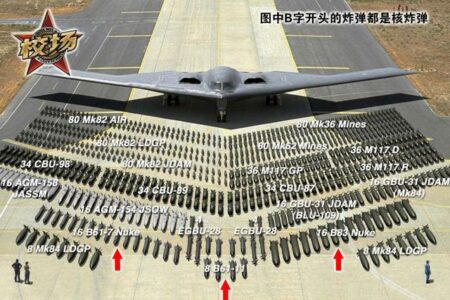
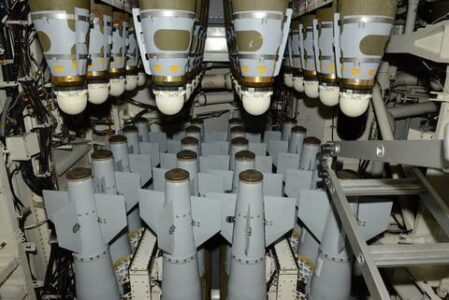
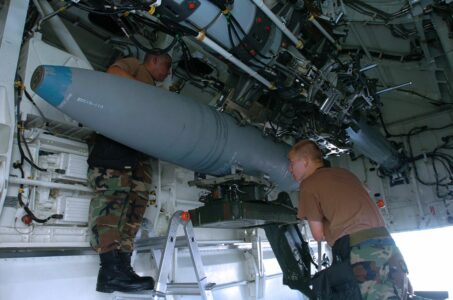
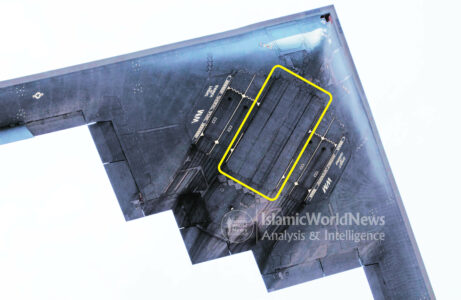
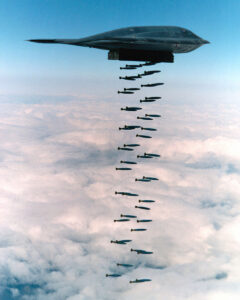
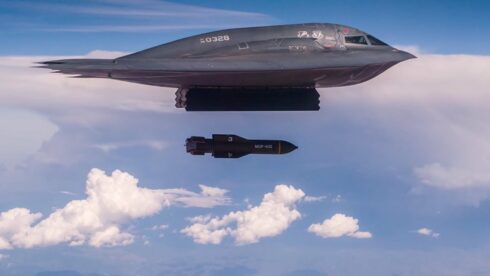
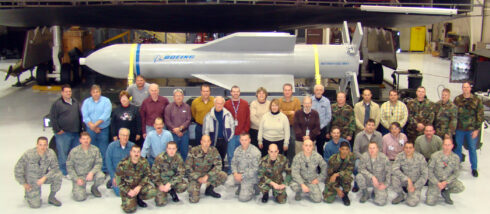

detectable, none the less
as the serbians said about the f117 they shot down “sorry, we didn’t know it was supposed to be invisible!”
long wave radar sees all. the “radar absorbent material” is likely a ruse. the whole trick is in not reflecting the radar signal back to the receiver.
miracle? not as much. they had some sam s 125 from romania and some from ukraine. just to put things straight.
and god forbid if they load them up with nukes and are successful with their target(s) there won’t be much time to celebrate a victory lap as those russian hypersonic missile technology that includes their ballistic missile suite (both land and sea) that have variants transferred to iran and china will mark the end of western civilization as we know it. “why”?… because russia’s patents on that technology will hit all the western targets faster than the west’s response!….
neo-cons are without wisdom .
america is one big gay disco: youtube.com/watch?v=rl-nkri74qk
e. michael jones —> the neocon song: youtube.com/watch?v=urw7plad_ky
lyrics in the info section.
muahahahahahaha hahahahah hahaha haha 😆😆😆
i’m sure laughin at that b-2 zi0ni$t suicide mission!…
remember when they said we couldn’t afford the wall?
interesting website the islamic world news first i have heard of it although the history is incomplete -missed out the fact they didn’t originally design it ,the nazi,s did .yes this is another german super weapon “exported ” ( stolen ) after america invaded germany in ww2 .they took all the scientists too.
and yes russia can spot it with its latest radar so it wont get near russia before being shot down.if you use google it cant be seen by russia but using yandex and reaching avia-pro.net yes russian radar can track the b2 -f35 and f22 using “over the horizon radar ” and the article is dated 2021.
its the fact that old “over the horizon radar ” developed in the 60,s uses longwave radar detection down near audio frequency that those usa stealth aircraft can be seen. submarine communications used to use longwaves as they can travel through the sea and land.
indeed.
iran is arguably the leader in ulf based radar.
most people already forgot, jew.s.a. and israel already tried to strike iran, but turned tail and ran when they got illuminated.
fafo, again. do it.
shut the fuck up and do it already!
they already flew f-35s into iran
up to near the border and u-turned, yes.
tried to pass it off as some exercise.
operation paperclip ?
the horten 229.
an absurdly expensive way to deliver munitions . everybody else just shoots from a distance . radar detection has also improved .
it’s all about the money; the more it costs, the more money northrop grumman shareholders make.
b2 = horten ho 229 !!!! zombi steal from germany in 1945 …..
our kites defeated the amerikunts—their transgender nation always loses
20th century tech in a 21st century world. its the sopwith camel of today.